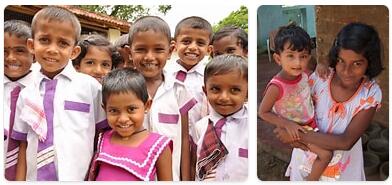Yearbook 2016
Sri Lanka. In January, the current population of Sri Lanka is 21,413,260. President Maithripala Sirisena announced that the internally displaced persons, up to 100,000, who were driven from their homes during the end of the war in 2009 would be allocated land to be able to build housing.

In the same month, the government presented a plan for a new constitution aimed at, among other things, “strengthening democratic rights and promoting national reconciliation”.
As a result of heavy and prolonged rainfall in May, Sri Lanka was hit by massive floods and landslides. At least one hundred people died in the floods, which were the worst in 25 years. Entire villages were submerged and more than 500 houses were destroyed, while over 4,000 were damaged. In addition, nearly 650,000 people were forced to flee their homes to seek shelter from the masses of water. The worst affected were the Colombo and Gampaha districts in the southwestern part of the country.
In June, the International Monetary Fund (IMF) approved a three-year US $ 1.5 billion loan to Sri Lanka for economic reform assistance.
In August, Parliament passed a law that could trace the thousands of people who disappeared during the 26-year-long civil war. In June, the Sri Lankan government acknowledged that around 65,000 people were missing since the war, something that has not been confirmed before.
For the first time since the end of the war in 2009, UN Secretary-General Ban Ki Moon visited Sri Lanka in September. During a speech in the capital Colombo, Secretary-General praised Sri Lanka’s willingness to approach peace and reconciliation, while emphasizing the country’s need for sustainable development work for human rights.
In a speech addressed to the UN Secretary-General the same month, President Sirisena presented his plan for the country’s steps towards “reconciliation, democracy and poverty reduction”. The president said, among other things, that Sri Lanka had had enough of a brutal war and that he wanted to proceed with the necessary measures to achieve peace and sustainable development. “My intention is to make the people of Sri Lanka the happiest in the world,” the president said, emphasizing that the main objective was to ensure a free society for all the people of the country.
In this year’s Press Freedom Index from Reporters Without Borders, Sri Lanka was ranked 141. It was a significantly better position than 2015, when the country had 165. In particular, it had become better for journalists working in the capital Colombo. In the northern part of the country, where the Tamils make up the majority of the population, the fears of journalists were still reported to be great.
The January 2015 presidential election was surprisingly won by New Democratic Front (NDF) Maithripala Sirisena with 51.3% of the vote. Rajapaksa had put up a 3rd period but had to settle for 47.6%. When Rajapaksa printed the November 2014 elections, he felt confident of winning. He controlled the press and could put the security forces and the military against the opposition, whatever he did. Sirisena had been Minister of Health in the Rajapaksa government, but resigned following Rajapaksa’s discharge of the election, after which he switched to the opposition. Here he succeeded in concluding agreements with the 36 main opposition parties and social organizations, and in return received their support for his candidacy. In late December, the Tamils announced that they also supported Sirisa’s candidacy. In the end, this became decisive, when the Tamils almost exclusively gave their voice to Sirisena. A final thank you to Rajapaksa who was an accomplice in the 50,000 Tamils genocide 6 years earlier.
The International Crisis Group (ICG) had warned in advance that Rajapaksa would likely attempt a coup if he lost. It also happened. On the night of January 9, when it became clear that Rajapaksa had lost, he and his brother, Defense Minister Gotabhaya Rajapaksa summoned Army Chief of Staff Daya Ratnayake, Chief of National Police NK Illangakoon and State Attorney Yuwanjana Wanasundera to a meeting. Rajapaksa tried to get his friends in the military and police to take power, declare the election invalid and introduce emergency, but the friends refused. Rajapaksa’s race had run. On January 9, several of his former ministers, family members and directors of state corporations resigned abroad.
As agreed, Sirisena appointed UDP chairman Ranil Wickremesinghe as prime minister. At the same time, Sirisena called on the former ruling party to join a national unity government. At the same time, Sirisena announced that he only planned to sit for a single term. The first was to be used to democratize the constitution on a number of points where Rajapaksa had previously changed it to something more authoritarian. Then later in 2015, parliamentary elections were to be held.
According to thereligionfaqs, the election in Sri Lanka was held in August and became a stinging defeat for the reigning UPFA, losing 18% and gaining 42.4% of the vote. Prime Minister Wickremesinghe’s UNFGG coalition, on the other hand, rose 16.3% to 45.7%. The Tamil National Alliance gained 4.6%. The UNFGG did not have an absolute majority, but lured the SFLP party out of the UPFA alliance, securing a majority so that Prime Minister Wickremesinghe could continue in office. The EU paid tribute to the war criminal state for its “respect for human rights”.